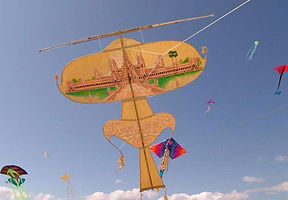
សិល្បៈ or Art
Khmer art is a stunning reflection of Cambodia’s spiritual depth, royal legacy, and everyday life. It spans centuries—from the grandeur of Angkorian temples to the delicate weaves of village crafts. Here's a breakdown of the main types of Khmer art, each with its own unique style and cultural significance:
Performing Arts
Khmer performing arts are visual poetry, blending movement, music, and myth.
Classical Dance (Robam Kbach Born): Dancers perform with slow, symbolic gestures that narrate divine stories.
Folk Dance (Robam Propainey): is a lively and expressive form of Cambodian traditional dance that reflects the daily life, customs, and ethnic diversity of the Khmer people. Unlike the refined gestures of classical court dance, folk dance is more energetic, accessible, and often performed during festivals, village celebrations, and community gatherings
Shadow Puppetry (Sbek Thom): Large leather puppets are used to enact epics like the Reamker (Khmer Ramayana), accompanied by traditional music.
Male Masked Dance (Lakhaon Khol): Masked dance drama, a majestic and ritualistic art form that blends classical dance, storytelling, and spiritual symbolism. Often performed by male dancers wearing elaborate masks, it dramatizes episodes from the Reamker—the Khmer version of the Indian epic Ramayana
Yike: A vibrant and dramatic form of Khmer musical theater, blending dance, singing, and storytelling into a circular stage performance that’s deeply rooted in Cambodia’s cultural and spiritual traditions
Lakhon Bassac: A vibrant and theatrical form of Khmer opera, blending drama, music, dance, and storytelling. It originated in the early 20th century near the Bassac River in what is now southern Vietnam, an area historically populated by Khmer Krom communities. This art form quickly gained popularity across Cambodia and remains beloved for its expressive style and emotional depth



_jfif.jpg)

Sculpture
Khmer sculpture is perhaps the most iconic form of Cambodian art, especially from the Angkor period (9th–15th centuries).
Stone Carving: Temples like Angkor Wat and Bayon are adorned with intricate bas-reliefs and statues of Hindu and Buddhist deities. These carvings often depict scenes from the Ramayana, Mahabharata, and Jataka tales.
Bronze Casting: Though less common, bronze sculptures of Buddha, Vishnu, and Shiva are considered national treasures. These were often used in temple rituals and royal ceremonies.
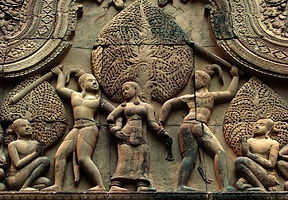
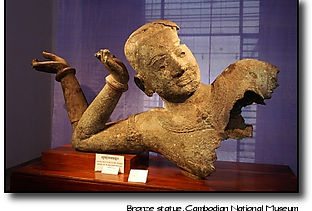
Painting
Painting in Cambodia has evolved from sacred murals to modern expressions of identity and resilience.
Temple Murals: Found in Buddhist pagodas, these murals narrate the life of the Buddha, moral parables, and local legends. They are painted with natural pigments and follow strict iconographic rules.
Modern Art: Post-Khmer Rouge, a new wave of artists emerged, blending traditional themes with contemporary styles. Today, Cambodian painters explore identity, trauma, and hope through vibrant canvases.


Textiles and Weaving
Textile arts are deeply embedded in Cambodian culture, especially in ceremonial and daily life.
Silk Ikat (Hol): A complex dyeing technique where patterns are dyed into threads before weaving. These are worn during weddings, dances, and religious events.
Cotton Weaving: Used for everyday clothing and household items, often featuring geometric or floral motifs.
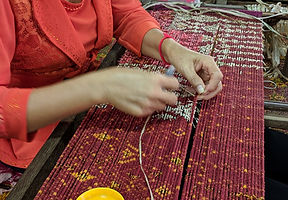
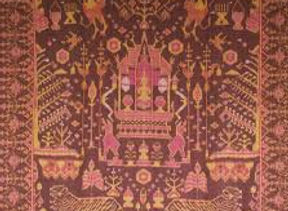
Ceramics
Khmer ceramics date back to prehistoric times and were essential for both domestic and ritual use.
Terracotta Pottery: Hand-shaped or wheel-thrown, decorated with incised patterns. Used for cooking, storing water, and holding offerings.
Glazed Wares: Introduced around the 9th century, featuring green and brown glazes. Animal motifs and utilitarian shapes were popular from the 11th to 13th centuries

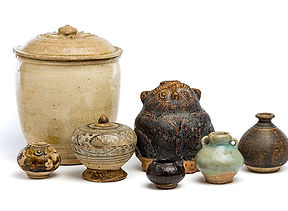
Lacquerware and Woodwork
These crafts combine utility with beauty, often used in religious and domestic settings.
Lacquerware: Made by layering resin and pigments over wood or bamboo. Used for offering trays, boxes, and ceremonial items.
Wood Carving: Found in temple doors, altars, and furniture. Designs often include lotus flowers, mythical beasts, and celestial dancers.


Metalwork and Silversmithing
Khmer metalwork is known for its fine detail and ceremonial importance.
Jewelry: Worn by dancers, brides, and royalty. Includes earrings, bracelets, and ornate belts.
Betel Nut Boxes and Ritual Items: Crafted with repoussé and filigree techniques, often featuring floral or animal motifs.

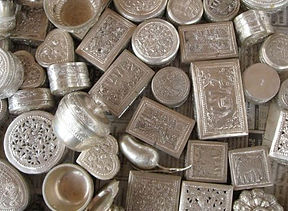
Traditional Crafts
These folk arts reflect Cambodia’s rural life and seasonal celebrations.
Kite-making: A joyful tradition during the dry season, with kites shaped like animals or spirits.
Basketry and Mat Weaving: Made from rattan, palm leaves, or bamboo. Used for storage, sleeping mats, and fishing gear.
